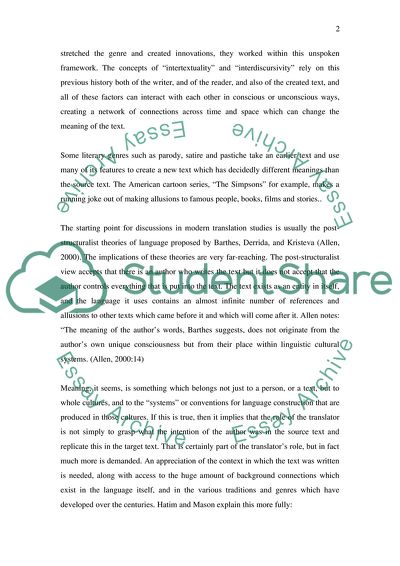Cite this document
(“The Concepts of Intertextuality and Interdiscursivity and the Essay”, n.d.)
The Concepts of Intertextuality and Interdiscursivity and the Essay. Retrieved from https://studentshare.org/sociology/1567985-discuss-the-concepts-of-intertextuality-andor-interdiscursivity-and-consider-the-adjustments-a-translator-has-to-make-in-order-to-convey-similar-implicatures-in-a-translated-version-choose-your-own-example-s
The Concepts of Intertextuality and Interdiscursivity and the Essay. Retrieved from https://studentshare.org/sociology/1567985-discuss-the-concepts-of-intertextuality-andor-interdiscursivity-and-consider-the-adjustments-a-translator-has-to-make-in-order-to-convey-similar-implicatures-in-a-translated-version-choose-your-own-example-s
(The Concepts of Intertextuality and Interdiscursivity and the Essay)
The Concepts of Intertextuality and Interdiscursivity and the Essay. https://studentshare.org/sociology/1567985-discuss-the-concepts-of-intertextuality-andor-interdiscursivity-and-consider-the-adjustments-a-translator-has-to-make-in-order-to-convey-similar-implicatures-in-a-translated-version-choose-your-own-example-s.
The Concepts of Intertextuality and Interdiscursivity and the Essay. https://studentshare.org/sociology/1567985-discuss-the-concepts-of-intertextuality-andor-interdiscursivity-and-consider-the-adjustments-a-translator-has-to-make-in-order-to-convey-similar-implicatures-in-a-translated-version-choose-your-own-example-s.
“The Concepts of Intertextuality and Interdiscursivity and the Essay”, n.d. https://studentshare.org/sociology/1567985-discuss-the-concepts-of-intertextuality-andor-interdiscursivity-and-consider-the-adjustments-a-translator-has-to-make-in-order-to-convey-similar-implicatures-in-a-translated-version-choose-your-own-example-s.


